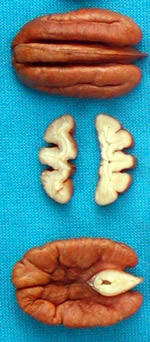This page has been archived and is being provided for reference purposes only. The page is no longer being updated, and therefore, links on the page may be invalid.
|
|
New High-Yielding Pecan Is Right for Many Regions
By Alfredo FloresOctober 24, 2007
A new pecan called "Lakota" is now available to nurserymen, thanks to scientists in the Agricultural Research Service's (ARS) Crop Germplasm Research Unit at College Station, Texas, and a collaborator at Kansas State University (KSU). Lakota is notable for its high yield potential, the early maturity and quality of its nuts, and excellent tree strength.
At the helm of this research effort were geneticist Tommy Thompson and horticulturalist L.J. Grauke, who conduct the ARS national pecan breeding program. Working with them was William Reid, a horticulturist at KSU at Chetopa.
Lakota kernels are cream to golden in color, and shell out easily into very attractive halves. There are 59 nuts per pound, of which 62 percent (about 10 ounces) is kernels and 6 ounces is shell. Lakota has early- to mid-season female flower receptivity and mid- to late-season pollen shed.
The new pecan has performed well in tests in the northern pecan production areas of Kansas, Missouri, Illinois, Oklahoma and Texas. Trees are vigorous and upright in growth habit and develop strong limb angles and a wind-resistant structure.
Lakota is very resistant to scab disease, an infection that causes premature nut drop and can prevent nuts from fully expanding, thus decreasing nut size. It also has medium susceptibility to yellow and black aphids that suck photosynthesis-produced sugars and plant nutrients from the leaves and excrete sticky honeydew. This aphid feeding damage also reduces the flow of nutrients to nuts, significantly reducing yields.
Lakota is a potential commercial cultivar for all pecan production areas. Initial data indicate that it is early enough in nut maturity to be grown in the northern production area, and it has enough scab resistance to be grown throughout the southeastern United States.
Small quantities of grafted trees will be available from selected nurserymen, beginning this winter.
ARS is the U.S. Department of Agriculture’s chief scientific research agency.


